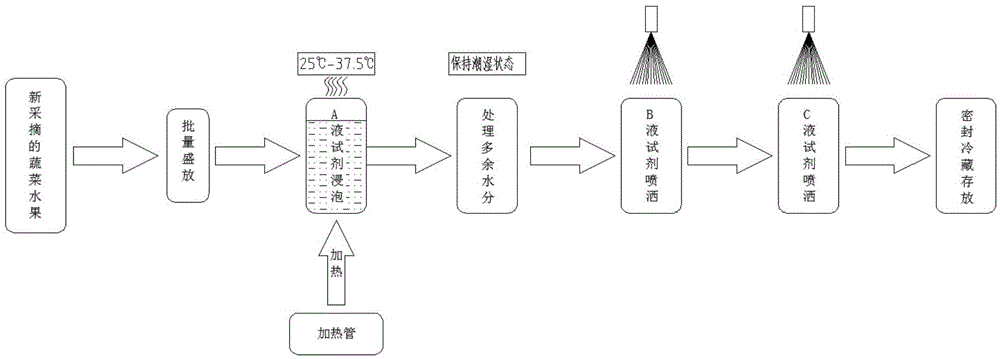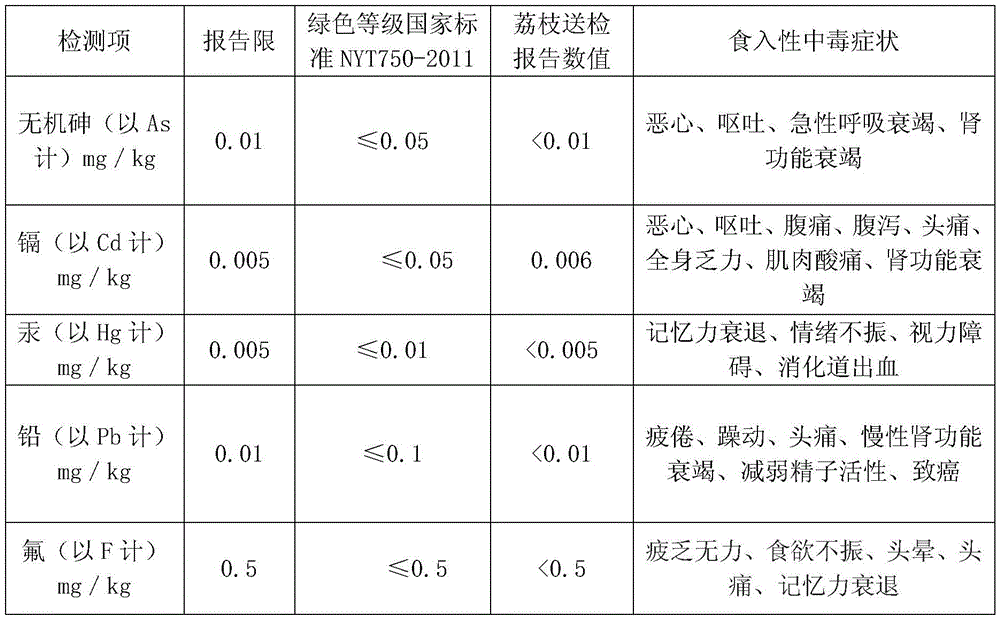Method for both degrading remaining pesticides in fruits and vegetables and keeping fresh
A technology for residual pesticides and fruits and vegetables, applied in the field of degrading pesticide residues in fruits and vegetables while keeping fresh, can solve the problems of large differences in the amount of pesticide residues, uneven methods of pesticide residues, etc., and achieve the effect of no toxic side effects
- Summary
- Abstract
- Description
- Claims
- Application Information
AI Technical Summary
Problems solved by technology
Method used
Image
Examples
Embodiment 1
[0037] A method for degrading residual pesticides in fruits and vegetables while keeping fresh comprises the following steps:
[0038] 1) Put freshly picked vegetables and fruits in full bloom;
[0039] 2) Soak vegetables and fruits in liquid A at 25°C for 2.5 minutes;
[0040] The A liquid, in terms of mass fraction, includes 0.1% biodegradation enzyme, 10% vegetable glycerin, and the balance is water;
[0041] 3) Dispose of most of the water droplets after the vegetables and fruits are soaked to make the surface of the fruits and vegetables moist;
[0042] 4) Spray B solution (chlorine dioxide reagent, chlorine dioxide concentration is 80ppm) on the surface of soaked vegetables and fruits;
[0043] 5) Spray liquid C (preservative with film) on the surface of soaked vegetables and fruits;
[0044]Said liquid C includes 1% xanthan gum, 1% citric acid and water as the balance in terms of mass fraction.
[0045] 6) Sealed and refrigerated for 8-12 hours.
Embodiment 2
[0047] A method for degrading residual pesticides in fruits and vegetables while keeping fresh comprises the following steps:
[0048] 1) Put freshly picked vegetables and fruits in full bloom;
[0049] 2) Soak vegetables and fruits in liquid A at 30°C for 2 minutes;
[0050] The A liquid, in terms of mass fraction, includes 0.3% biodegradation enzyme, 8% vegetable glycerin, and the balance is water;
[0051] 3) Dispose of most of the water droplets after the vegetables and fruits are soaked to make the surface of the fruits and vegetables moist;
[0052] 4) Spray B solution (chlorine dioxide reagent, chlorine dioxide concentration is 40ppm) on the surface of soaked vegetables and fruits;
[0053] 5) Spray liquid C (preservative with film) on the surface of soaked vegetables and fruits;
[0054] Said liquid C includes, by mass fraction, 0.5% xanthan gum, 1.5% citric acid, and the balance is water.
[0055] 6) Sealed and refrigerated for 8-12 hours.
Embodiment 3
[0057] A method for degrading residual pesticides in fruits and vegetables while keeping fresh comprises the following steps:
[0058] 1) Put freshly picked vegetables and fruits in full bloom;
[0059] 2) Soak the well-packed vegetables and fruits in liquid A at a temperature of 37.5°C for 1.5 minutes;
[0060] The A liquid, in terms of mass fraction, includes 0.2% biodegradation enzyme, 15% vegetable glycerin, and the balance is water;
[0061] 3) Dispose of most of the water droplets after the vegetables and fruits are soaked to make the surface of the fruits and vegetables moist;
[0062] 4) Spray B solution (chlorine dioxide reagent, chlorine dioxide concentration is 120ppm) on the surface of soaked vegetables and fruits;
[0063] 5) Spray liquid C (preservative with film) on the surface of soaked vegetables and fruits;
[0064] Said liquid C includes 2% xanthan gum, 0.5% citric acid and water as the balance in terms of mass fraction.
[0065] 6) Sealed and refrigerat...
PUM
 Login to View More
Login to View More Abstract
Description
Claims
Application Information
 Login to View More
Login to View More - R&D
- Intellectual Property
- Life Sciences
- Materials
- Tech Scout
- Unparalleled Data Quality
- Higher Quality Content
- 60% Fewer Hallucinations
Browse by: Latest US Patents, China's latest patents, Technical Efficacy Thesaurus, Application Domain, Technology Topic, Popular Technical Reports.
© 2025 PatSnap. All rights reserved.Legal|Privacy policy|Modern Slavery Act Transparency Statement|Sitemap|About US| Contact US: help@patsnap.com



